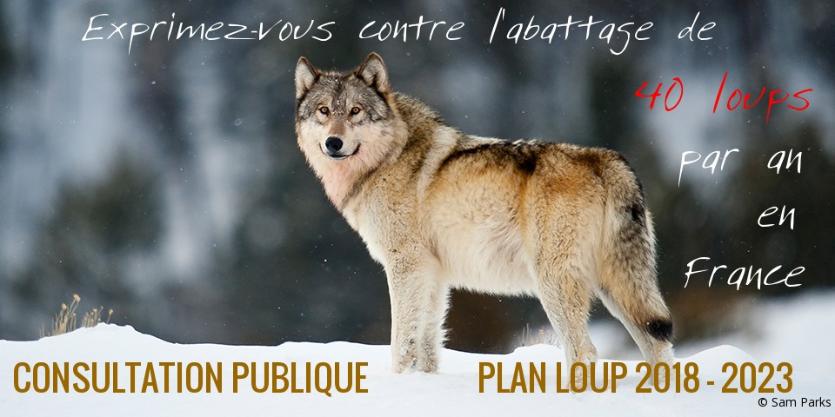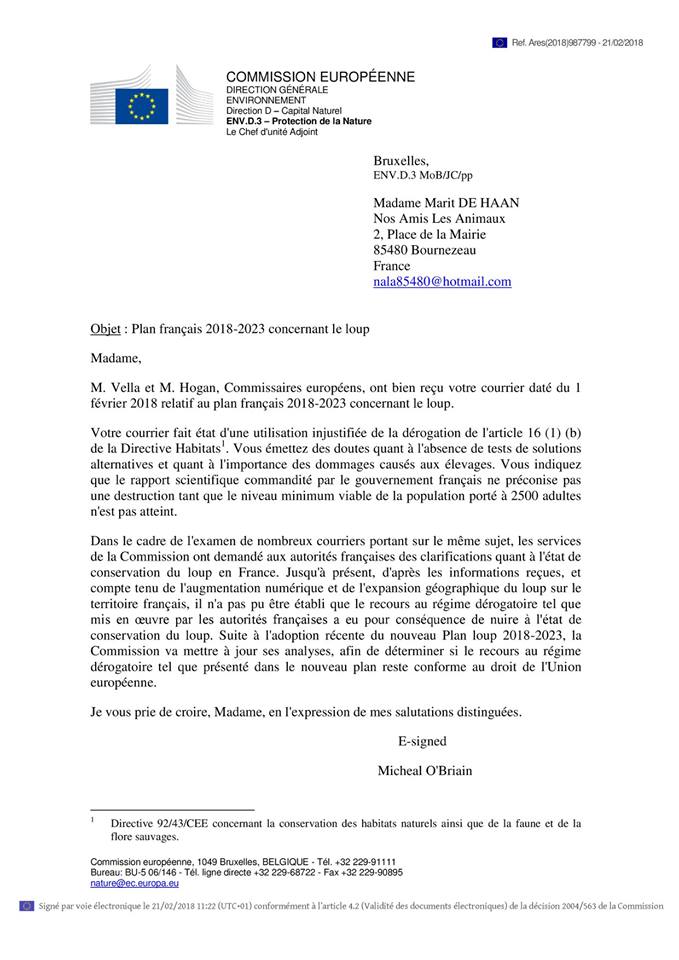Translate This Page
Below you'll find the response of the European Commission
Ci-dessous vous trouverez la réponse de la Commission Européenne

Letter to European Commissioner for the environment, maritime affairs and fisheries, Mr Karmenu Vella and European Commissioner for agriculture and rural development, Mr Phil Hogan
Subject: French plan concerning the wolf 2018 - 2023 “Plan Loup”
Bournezeau, 1 February 2018
Dear Sir,
The French government has recently ended a consultation on their Projet de plan d’action national sur le loup et les activités d’élevage pour la période 2018-2023 (Plan Loup) http://www.consultations-publiques.developpement-durable.gouv.fr/IMG/pdf/pna2018-2023_-_consultation.pdf
One of the propositions that is put forward is to allow 10% of the population to be shot each year. (See page 66): "L’arrêté définissant le nombre de loups pouvant être détruits au cours d’une année, de manière à ce que les destructions de loups ne nuisent pas au bon état de conservation de l’espèce (arrêté « plafond ») prévoira que ce nombre est fixé pour une année civile, allant du 1er janvier au 31 décembre.
Afin de fixer ce nombre maximum, les scientifiques recommandent de ne pas abattre plus de 10 à 12 % de l’effectif afin de ne pas remettre en cause la viabilité de l’espèce. Sur cette base, la détermination du plafond de loups pouvant être détruits se fondera chaque année sur les résultats du suivi régulier de l’effectif de loups moyen annuel, estimé par l’ONCFS au printemps de chaque année.
Afin d’assurer la transition avec la gestion de l’année 2017 (et le passage à l’année civile), le plafond initial pour l’année 2018 sera établi à 40. Il sera actualisé une fois connus les chiffres de la population au printemps, pour être porté à 10 % de la population.
À partir des années suivantes, le plafond sera fixé à 10 % de l’effectif moyen annuel. Dans l’hypothèse où ce plafond serait atteint avant la fin de l’année civile, le préfet coordonnateur aura la possibilité d’activer l’autorisation de tirs de défense additionnels dans la limite de 2 % supplémentaire. "
They claim that this is justified on the basis of a report that they commissioned:" Expertise scientifique collective sur le devenir de la population de loups en France
DEMARCHE D’EVALUATION PROSPECTIVE A L’HORIZON 2025/2030 ET VIABILITE ALONG TERME"
The wolf is included in Annex V of the Council Directive 92/43/EEC of 21 May 1992 on the conservation of natural habitats and of wild fauna and flora.
Therefore killing one is prohibited unless one of the derogations mentioned in Article 16 applies. The French government claim that a derogation is justified under article 16 1. (b) to prevent serious damage to livestock. We responded to the public consultation and you can read our full submission here. We concluded that the derogation is not justified for the following reasons:
- there is a large discrepancy between the number of livestock animals killed in France compared to its neighbours. In France the rate is approximately 25 animals killed per wolf per year. In Germany the figure is close to one animal killed per wolf per year, in Italy it is about two and in Spain about three. It is clear that there is room for an improvement in the methods used to protect livestock as a satisfactory alternative to killing wolves.
- the meaning of "serious damage" is not defined. However, a reasonable interpretation is that it is seen in comparison with other causes of damage. The consultation document does not give figures for such losses so a meaningful comparison is not possible. We have not been able to find official statistics, but unconfirmed figures suggest that over 100,000 sheep are lost per year due to stray dogs, lightning and falling off cliffs. The French government should provide the appropriate statistics. If they confirm the significant losses by other causes it would show that wolves do not cause serious damage to livestock.
- the “Plan Loup”claims that the scientists support the idea of a cull of 10% of the wolf population per year. This is a misinterpretation of their conclusions. ( See page 29+ from the scientific report "Expertise scientifique collective..." mentioned above) The scientists suggest a minimum viable population requires "une taille efficace" of 500. Une taille efficace of 500 corresponds to 2,500 to 5,000 adults. (see page 23) The current population is estimated to be a maximum of 402 wolves of all ages, including juveniles. It is currently below the minimum viable population of 2,500 adults. Therefore a cull is not justified as it will bring a significantly increased risk of extinction within 100 years. In any case, a plan that only aims to prevent the extinction of a species over the next 100 years is no guarantee that the species will not be extinct after 101 years, nor that a viable population will exist in 100 years time.
- to be viable a population must have sufficient numbers and genetic diversity. The scientists estimate that 2,500 - 5,000 adults is the minimum population required to ensure sufficient genetic diversity for long term survival. (see page 23) They also estimate that the current rate of growth of the wolf population is between 5- 25%. For their models they use 12%. The current population according to the “Plan Loup” is at most 402 wolves of all ages. If we use a rate of growth of 12% and assume that all the existing wolves are adults then the minimum population of 2,500 adults could be reached in 16 years, 5.000 would be reached in 23 years. However the “Plan Loup” proposed by the French government wants a systematic cull of 10% of the population of 402 animals. This reduces the growth rate to 2%. Therefore it would take 90 years for the population to reach 2,500 adults and 130 to reach 5,000. This significantly increases the chance of too much inbreeding.
- the scientists also modelled the viability of a population based on it's mortality rate. A mortality rate of 34 % leads to a decline in the population. (Figure 9, page 33) The current rate is estimated at 22%. (see box, page 36). If culling is allowed at the rate of 40 animals for an estimated population of 402 animals (+/- 10% increased mortality) then it brings the mortality rate to 32%. If the population is less than 333, then culling 40 wolves would be 12% extra mortality which would lead to a decline in the population and therefore long term extinction. The plan currently envisages allowing a cull of up to 12%: according to the scientists' models this would lead to a fall in the population.
In conclusion, we believe that the derogation that France intends to apply is not authorised under article 16 because :
- there are doubts that effective alternative measures have been tried;
- the serious nature of the damage caused by wolves has not been shown;
- the scientific report commissioned by the French government does not support a cull before a minimum viable population has been achieved therefore the derogation would be detrimental to the maintenance of the population of the species at a favourable conservation status;
- the plan proposes that the cull be fixed at a minimum of 10% every year for the period of the plan based on the size of the estimated population. This is not acceptable as it means that the cull could continue even if no serious damage occurs and also if the population declines.
We ask you to investigate the proposal and take whatever steps are necessary to ensure that it complies with the directive.
Yours sincerely,
Marit de Haan
Copies of this letter will be sent to the European Parliament and to the appropriate foundations and associations for wolf conservation in Europe.

